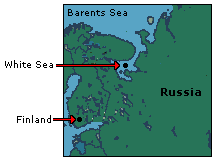

|
The White Sea is an arm of the Barents Sea. It forms an indentation in the coast of northwestern Russia and is partly enclosed on the north by Kola Peninsula. It is 580 km (360 mi) long and has an area of 90,000 sq km (30,000 sq mi). The White Sea receives the waters of numerous rivers. The flow of fresh water into the Sea is responsible for relatively low salinity. This results in a large part of its surface being frozen from November to May annually. The sea contains highly productive herring, cod, and seal fisheries. It is linked to the Baltic Sea by an inland waterway.   The southern part of the White Sea, north of Russia, is home to the beluga whale. Like many species in the arctic region, the adult individuals are completely white. Although the land mass around the White Sea is not Arctic in character, but Boreal, the marine environment through the connection to the northern Barents Sea can be considered Subarctic. Every year in July and August when daylight lasts for close to 24 hours, a large group of belugas assemble near the coast of the Solovetsky archipelago in the White Sea to socialize with each other. Another marine mammal to make the White Sea its home is the Harp Seal. Here the seals give birth to their pups on the ice. Typically, during the spring thaw the ice sheets break up and flow with the currents northward into the Barents Sea, the seals' spring feeding grounds. The seal pups hitch a ride on the ice floes, living on their own individual stores of fat until they arrive in the Barents Sea. Their mothers having departed for the Barents Sea weeks before. In a normal year, the seal pups' trip from the White Sea out to the Barents takes about six weeks and the seals have adapted to rely upon this mechanism of mother nature. During their yearly migration, the mother seals usually stay with their pups and feed them until their pelts turn from white to gray-a sign that the pups are mature enough to swim and feed themselves.
|